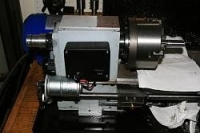Been wanting to do this for a long time and I finally got aroundtoit!
Found this gear motor on eBay:
https://www.ebay.com/itm/COLEMAN-GEA...B19y:rk:1:pf:0
Mine came with the mounting plate shown in the description photos.
I am powering mine with a 15VDC 1amp wall transformer. (wall wart?)
Used a variable dc power supply module from the bay also to control the low speed motor.
This was an easy build since I already had made up 4 banjos like this:
http://www.homemadetools.net/forum/m...2148#post75832
It was a simple matter to make an adapter to mate the 1/4" shaft to the smallest change gear I had.
Put the 80 tooth gear on the lead screw and there it was. Fine....That is Very Fine Feed.
With this setup the lead screw speed is independent of the spindle speed.
With the gears I selected the lead screw rpm is from 1 to 5 depending on the voltage being fed the motor.
Plenty of torque to drive the carriage.
I was able to take .0005" and have an almost polished finish on a piece of rather hard steel.
On the example picture of the turned shaft you can see the rough finish near the chuck.
That was done by hand and going slow. The right hand section was done at about 3 rpm on the lead screw.
Simple matter to put the change gears back on for threading or even the original banjo with the 80 20 80 20 gears
for a coarse feed.
So far so good.
Cheers, JR



 LinkBack URL
LinkBack URL About LinkBacks
About LinkBacks


 Reply With Quote
Reply With Quote




Bookmarks